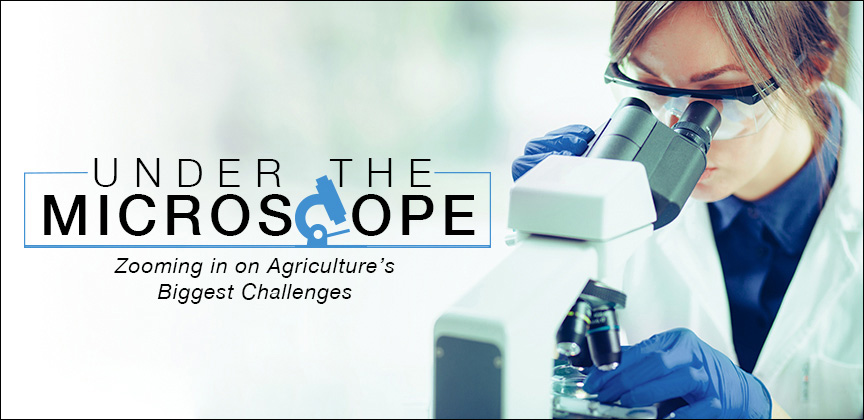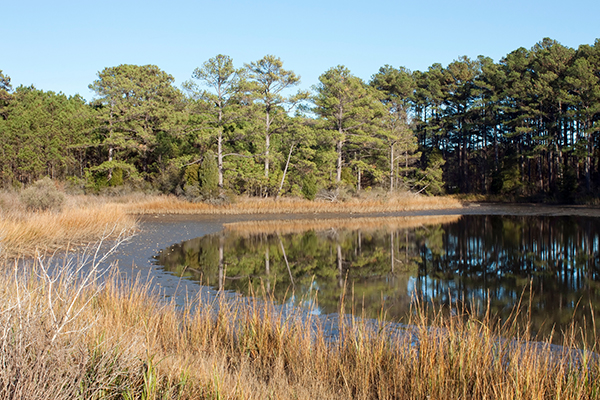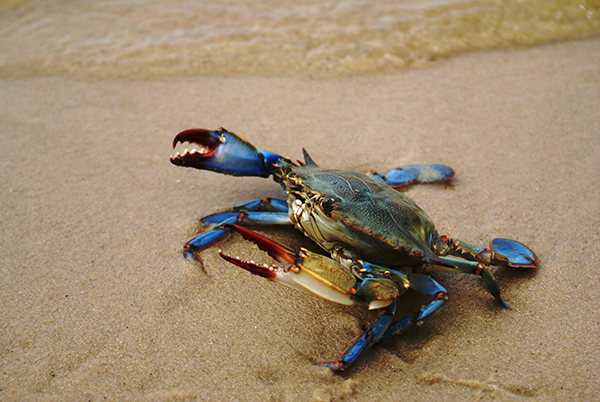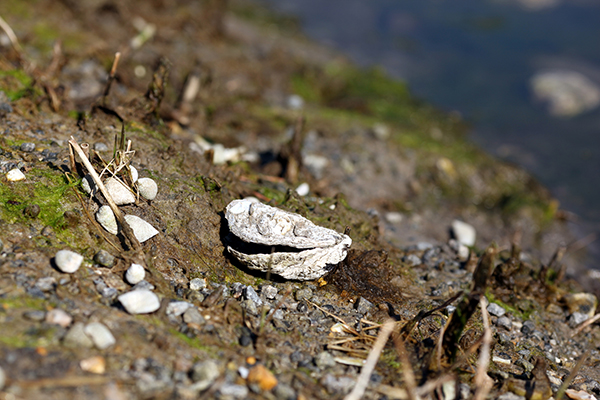
Improving the Water Quality of the Chesapeake Bay
 Great Blue Heron standing on a small island watching a beautiful Chesapeake Bay sunset in Maryland. (Photo courtesy of Patrick Davis, Getty Images) Great Blue Heron standing on a small island watching a beautiful Chesapeake Bay sunset in Maryland. (Photo courtesy of Patrick Davis, Getty Images) |
Tamie Veith is an Agricultural Engineer with the ARS Pasture Systems and Watershed Management Research Unit in University Park, PA. Her research involves the development of cost-effective farm management practices, as well as water quality modeling. |
Welcome Dr. Veith to Under the Microscope:
UM: The Chesapeake Bay is the largest and most productive estuary in the United States. What is the regional, national, and global importance of the Bay?
TV: The Bay provides food sources, recreational opportunities, and access to major shipping routes. Research to better understand the Bay's ecosystem services (e.g., water quality, soil health, wildlife habitat, food production) benefits not only the United States, but also informs conservation efforts in the other global estuaries, like the Baltic Sea.
UM: The Bay also comprises many different watersheds across several states. These local watersheds are pathways to the Bay, and therefore, what ends up in these watersheds can drain into the bay. What is the relationship between the Bay and agriculture in those areas?
TV: Rainfall from these watersheds provides crops with water, which moves through the soil and travels to the streams. As the water moves, it picks up agricultural chemicals, nutrients, sediment, and a variety of other compounds which can end up in the Bay. Although agriculture in this region benefits people nationally and globally, many of these compounds make their way downstream of where they are intended. These excess compounds impair the water quality, soil health, crops, and animals throughout the Bay watersheds and in the Bay.
UM: What are some of the problems with the Bay that you and your team hope to solve?
 The Chesapeake Bay is the largest estuary in the United States and third largest in the world. An estuary is a body of water where fresh and salt water mix. (Photo courtesy of Yvonne Navalaney, Getty Images)
The Chesapeake Bay is the largest estuary in the United States and third largest in the world. An estuary is a body of water where fresh and salt water mix. (Photo courtesy of Yvonne Navalaney, Getty Images)
TV: It is important to understand where pollutants are coming from and how they move. We are looking at ways to treat pollutants through vegetative buffers along streams, changes in farm management, and consumer awareness of how to minimize pollutants in our environment.
For instance, we were involved in evaluating the 20,000 riparian buffers in and around the Bay's 64,000 square mile watershed. We found that, historically, these buffers helped improve water quality, and that real opportunity exists to better place them so larger benefits can be accrued. Right now, these buffers result in about a 20-30 percent reduction in agricultural nutrient runoff. With improved management of these buffers, we can reach up to a 50 percent reduction.
UM: What factors led to the Bay being in its current condition?
TV: The Chesapeake Bay watershed is enormous, and there are so many contributing factors to its current condition. On top of that, the Chesapeake Bay watershed has experienced significant land use changes, largely due to population increases and the resulting necessary increases in food production, developed land use, and industrialization. Historically, everything from our treatment of wastewater to development of urban areas to management of agriculture and forests have all been part of the Chesapeake Bay's current water quality situation.
From an agricultural perspective, there have been major strides in implementing best management practices to reduce runoff from farms. However, more can be done.
 Approximately half the water in the Bay comes from the 64,000 square mile watershed. (Photo courtesy of Getty Images)
Approximately half the water in the Bay comes from the 64,000 square mile watershed. (Photo courtesy of Getty Images)
UM: What are the pollutants that you aim to reduce? Where do these pollutants come from?
TV: We try to minimize losses of crop fertilizers, pesticides, manure, and soil from crop fields. These all become pollutants when applied in excess of crop needs or when not applied at a time, rate, or manner in which they can be used by the crops.
Other chemicals we try to reduce include "emerging contaminants" that come from agriculture as well as other sources. For example, pharmaceuticals, ingredients in personal care products, microplastics, and PFAS (per- and polyfluoroalkyl substances) can all be introduced, inadvertently, into agricultural fields when manure, wastewater, and even biosolids are land-applied to provide nutrients to our crops. These chemicals are biologically active and can pose threats to fish and other sensitive aquatic species at trace-level concentrations.
UM: What kind of impact have these pollutants had on marine life in the Bay, such as fish, oysters, and crabs?
TV: There is a bioaccumulation that occurs over time, and it can affect fisheries and people who consume seafood from the Bay. That's of particular concern for the emerging contaminants. For nutrients, they fertilize the Bay just as they do for agricultural crops, resulting in algal blooms and low oxygen levels that are harmful for the aquatic ecosystem within the Bay.
UM: How are these pollutants a concern outside of the Bay? Does controlling them help people or ecosystems that are upstream, in the massive watershed?
TV: In putting best management practices into place to improve the Bay's watersheds, we are improving the health of their watersheds and our local waterways, which in turn helps improve the health of the Bay and its inhabitants.
 The Chesapeake Bay is home to Maryland's famous Blue Crab. Approximately 280 million crabs lived in the Bay in 2021. (Photo courtesy of Sandy Franz, Getty Images)
The Chesapeake Bay is home to Maryland's famous Blue Crab. Approximately 280 million crabs lived in the Bay in 2021. (Photo courtesy of Sandy Franz, Getty Images)
UM: What methods/tactics have you and your team developed to improve the water quality in the Chesapeake Bay?
TV: We use combinations of experimental studies, observational data collection, simulation modeling, data mining, focus groups, stakeholder workshops, and surveys to understand how activities within agricultural systems impact the environment, both on and off the farm. From this research, we have developed best management practices and strategies to help farmers enhance their animal feeding strategies, lower nutrients coming into their farms, improve soil health conditions, and reduce nutrient runoff.
UM: Farmers must balance crop production with responsible land stewardship. How do the 'best management practices' that you and your team design help farmers?
TV: Some of the practices help farmers to understand the risks and costs of adding crop amendments, so they can evaluate their use and minimize excess applications of amendments. Other practices help by keeping crop amendments in the soil near the crops so the crops have the best chance of using them. Finally, amendments that do leave the agricultural fields are captured or treated by 'best management practices' to reduce their impact to the off-farm environment.
For example, we've studied a wide array of manure injection technologies (adding manure directly into the soil) to provide farmers with options so they don't spread manure on the surface of the fields. This keeps the nutrients in the soil, where they are more likely to be used by crops and less likely to end up in our waterways.
 Oysters are a critical part of the Chesapeake Bay, as they help filter the water and remove excess nutrients like nitrogen from the water. They also grow in reefs that provide habitat for fish and crabs. (Image courtesy of Getty Images)
Oysters are a critical part of the Chesapeake Bay, as they help filter the water and remove excess nutrients like nitrogen from the water. They also grow in reefs that provide habitat for fish and crabs. (Image courtesy of Getty Images)
UM: How are climate change and other pressures (increased population and development, for example), affecting the Bay?
TV: Although we have made great progress in understanding and reducing nutrient runoff into the Bay, work is just beginning on minimizing impacts of other compounds such as PFAS , microplastics, and insecticides.
Additionally, as climatic factors create more extreme weather events, agricultural management practices and watershed planning need to be dynamic and forward-thinking at both the local community level and at larger scales. For example, research has shown that most of the contaminants are mobilized during large storm events. As the frequency of such large events increases, our mitigation strategies need to increasingly target these extreme weather events to effectively reduce the types and amounts of pollutants entering the Bay.
UM: What can the average person do to lessen the pollution in the Bay?
TV: Although the water quality issues facing the Bay are complex, there is tremendous amount of material that can be found on-line related to these issues. In terms of day-to-day decisions, using resources wisely is helpful. For example, fertilize lawns based on package guidelines; recycle unused medicines, paints, and hazardous wastes through proper community channels; and use personal care products that help minimize your environmental footprint. You can learn more here.
